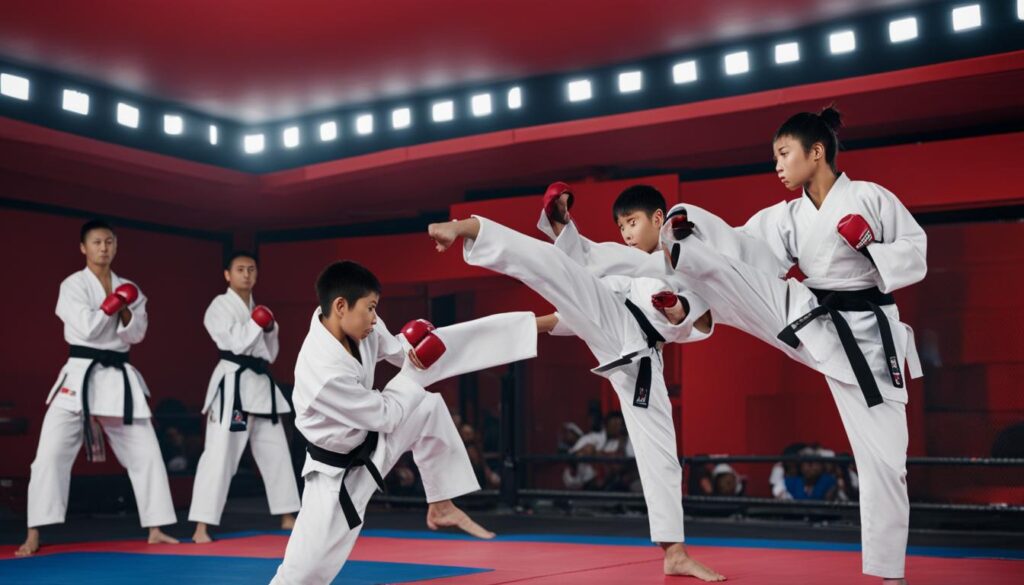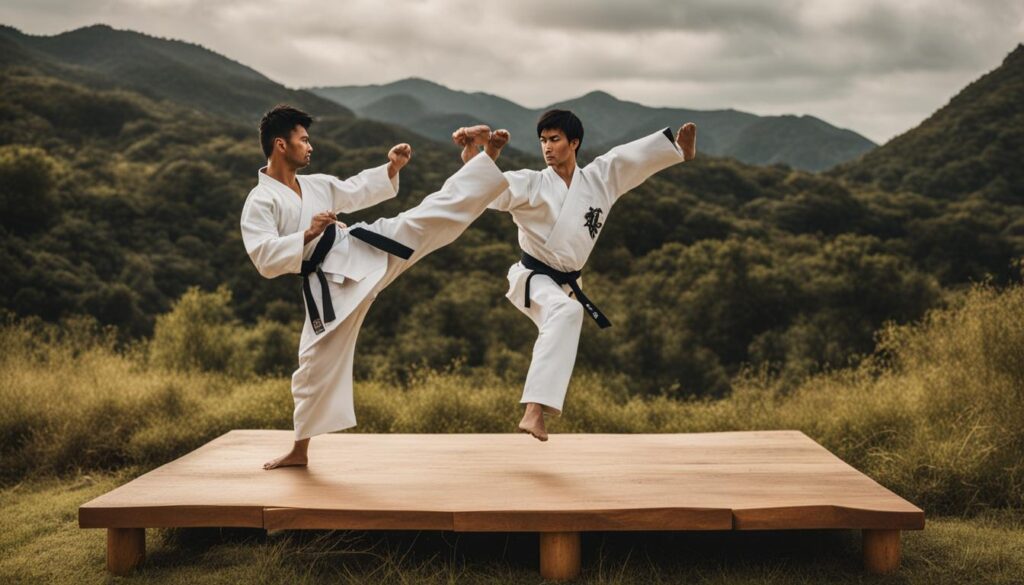When it comes to martial arts, karate and taekwondo are two popular disciplines that offer a host of physical and mental health benefits. Whether you are looking to learn self-defense, improve your fitness, or develop discipline, both karate and taekwondo can be excellent choices. But how do you decide which one is better for you?
In this article, we will compare karate and taekwondo to help you make an informed decision. We will explore their origins, techniques, competitions, training methods, and the numerous benefits they offer. By the end, you will have a better understanding of the unique qualities of each martial art and which one aligns better with your preferences and goals.
Key Takeaways:
- Karate and taekwondo are both popular martial arts forms that offer physical and mental health benefits.
- Karate emphasizes hand techniques, while taekwondo focuses more on kicks.
- The choice between karate and taekwondo depends on personal preferences and goals.
- Both martial arts require discipline, perseverance, and mental fortitude.
- Karate and taekwondo can be practiced by individuals of all ages and fitness levels.
The History of Karate and Taekwondo
Karate and taekwondo both have rich histories that span centuries. Understanding their origins and development can provide valuable insights into these martial arts forms.
Karate, which originated around 500 years ago on the Japanese island of Okinawa, was created as a means of self-defense. During a period when weapons were banned to prevent war, the people of Okinawa needed a way to protect themselves. Karate was born out of this necessity and developed with influences from both Japanese and Chinese martial arts styles. Over time, different karate styles emerged, each with its own unique techniques and philosophies.
Taekwondo, on the other hand, has a history that dates back even further. It can be traced back to 50 B.C.E. in Korea. Initially developed as a means of self-defense, taekwondo was designed to utilize the entire body for protection. Its emphasis on kicks and fast, powerful movements distinguishes it from other martial arts forms. Today, taekwondo has evolved into a sport and has gained international recognition, becoming an Olympic event.
The historical backgrounds of karate and taekwondo contribute to their unique approaches to self-defense and martial arts training. Understanding their origins can help individuals make informed decisions when choosing a martial arts form that aligns with their personal goals and interests.
Techniques and Styles
One of the key differences between karate and taekwondo lies in their techniques and styles. Both martial arts have distinct approaches to combat, emphasizing different aspects of fighting.
Karate: Karate is renowned for its hand techniques, with kicks being used as backups. The primary focus in karate is on strikes, punches, and blocks. Practitioners learn a variety of hand techniques that enable them to strike effectively and defend against incoming attacks. Stances play a crucial role in karate, providing a solid foundation for executing powerful strikes.
Taekwondo: In contrast, taekwondo places a greater emphasis on kicking techniques. Taekwondo practitioners learn a wide array of kicks, including spinning and jumping kicks. This martial art showcases high and fast kicks that demonstrate agility and flexibility. Stances in taekwondo tend to be more mobile, allowing practitioners to swiftly transition between different kicks and strikes.
While karate primarily focuses on hand techniques and incorporates kicks, taekwondo primarily relies on powerful and dynamic kicks. Each martial art has its own unique set of moves, combination techniques, and training methods that students learn and practice.
Competitions and Rules
Both karate and taekwondo offer competitive opportunities for individuals of all ages to showcase their skills, improve fitness, and develop discipline. Competitions in these martial arts have specific rules and guidelines that participants must adhere to. Let’s take a closer look at the tournaments in karate and taekwondo:
Karate Tournaments

Karate tournaments involve a range of competitive events where athletes demonstrate their techniques and abilities. Points are awarded for both punches and kicks, making it a well-rounded competition that tests various aspects of a participant’s skill set. Judges evaluate the competitors based on their execution, form, and technique. The scoring system varies depending on the style and organization, but the objective is to accurately measure the participants’ performance.
Taekwondo Tournaments
Taekwondo competitions focus heavily on kicking techniques. Participants aim to deliver fast, powerful, and precise kicks to score points. In taekwondo tournaments, higher points are awarded for kicks compared to punches. This emphasis on kicking reflects the unique characteristics and style of taekwondo, which places a significant emphasis on leg movements. Similar to karate tournaments, taekwondo events have specific rules and regulations that govern the scoring and conduct of the competition.
Both karate and taekwondo competitions provide a platform for athletes to showcase their abilities and compete against others who share their passion for the martial arts. These tournaments are not limited to a specific age group, making them accessible to participants of all ages, including children, adults, and seniors. Participating in these competitions not only helps individuals improve their fitness levels but also cultivates discipline, sportsmanship, and mental resilience.
| Karate Tournaments | Taekwondo Tournaments |
|---|---|
| Award points for both punches and kicks | Give higher points for kicks |
| Varied scoring systems based on style and organization | Specific scoring rules and guidelines |
| Inclusive of participants of all ages | Accessible to children, adults, and seniors |
Training and Discipline
Both karate and taekwondo require discipline and mental strength. Training in these martial arts forms helps develop focus, perseverance, and self-control. Students learn and practice various techniques and forms to hone their skills.
The training process teaches patience and encourages personal growth. Karate and taekwondo provide a structured environment for individuals to cultivate discipline and commitment. Through dedicated training, practitioners of karate and taekwondo develop the mental fortitude to overcome challenges and push themselves to new limits.
Whether it is meticulously perfecting their technique or persevering through demanding training regimes, the discipline instilled by karate and taekwondo carries over into other aspects of life. This characteristic is especially valuable outside the dojo, enabling practitioners to approach challenges with determination and resilience. The mental strength developed through martial arts training enhances overall well-being and leads to personal growth.
Overall, the training and discipline required in both karate and taekwondo contribute to the holistic development of an individual, fostering perseverance, self-control, and mental resilience. These martial arts are not only physical practices but also provide individuals with the necessary tools for personal growth and success in all aspects of life.
Benefits of Karate and Taekwondo
Karate and taekwondo offer numerous benefits for individuals of all ages. Engaging in these martial arts forms not only improves physical fitness but also enhances self-defense skills and promotes self-confidence. Through consistent practice, individuals develop self-discipline, focus, and mental resilience.
Both karate and taekwondo can be practiced by children, adults, and seniors, making them inclusive martial arts choices for individuals at different stages of life. These disciplines provide a structured and fun way to stay active and maintain overall well-being.
Whether you choose karate or taekwondo, you will experience the positive impact these martial arts have on your physical fitness, self-defense abilities, and self-confidence.

Comparison of Benefits
| Benefits | Karate | Taekwondo |
|---|---|---|
| Improves physical fitness | ✓ | ✓ |
| Enhances self-defense skills | ✓ | ✓ |
| Promotes self-confidence | ✓ | ✓ |
| Develops self-discipline | ✓ | ✓ |
| Builds focus and mental resilience | ✓ | ✓ |
| Suitable for all ages | ✓ | ✓ |
Conclusion
When it comes to choosing between karate and taekwondo, there are a few key factors to consider. Personal preferences, fitness goals, and self-defense needs should all be taken into account. Karate focuses on hand techniques and offers a balanced approach that incorporates both hand and leg movements. It is ideal for individuals who want a well-rounded martial arts experience. On the other hand, taekwondo places a greater emphasis on kicking and is perfect for those who aspire to develop fast and powerful kicks.
Both karate and taekwondo provide physical and mental benefits. Engaging in either of these martial arts forms can improve fitness, build strength, enhance flexibility, and boost cardiovascular health. Additionally, they offer self-defense skills that can be valuable in real-life situations. The choice between karate and taekwondo ultimately depends on individual preferences and goals.
For those seeking a more balanced combination of hand and leg movements for self-defense and fitness, karate is the preferred choice. If you have a specific interest in fast and powerful kicks, taekwondo can be a great fit. Regardless of the choice, both karate and taekwondo provide a structured and disciplined environment for personal growth and overall well-being. So, whether you are looking to improve your self-defense skills or get fit, karate and taekwondo are excellent options to consider.
FAQ
Is karate or taekwondo better for self-defense?
Both karate and taekwondo can be effective for self-defense, but it depends on personal preference and training.
What are the main differences between karate and taekwondo techniques?
Karate emphasizes hand techniques and uses kicks as backup, while taekwondo focuses more on kicking techniques.
Can children practice karate or taekwondo?
Yes, both martial arts forms are suitable for children and can help develop discipline and confidence.
Are there competitions for karate and taekwondo?
Yes, both karate and taekwondo have competitions with specific rules and guidelines.
How do karate and taekwondo benefit physical fitness?
Both martial arts forms offer a full-body workout, improve muscle strength, and enhance balance and flexibility.
Can adults practice karate or taekwondo?
Absolutely, both karate and taekwondo are suitable for adults and can be practiced for physical fitness and self-defense.
Do karate and taekwondo require discipline and mental strength?
Yes, training in both martial arts forms helps develop discipline, focus, perseverance, and self-control.
What are the benefits of practicing karate and taekwondo?
Practicing karate and taekwondo improves physical fitness, enhances self-defense skills, promotes self-confidence, and fosters mental resilience.
Which martial art should I choose, karate or taekwondo?
The choice between karate and taekwondo depends on your personal preferences, fitness goals, and self-defense needs.
